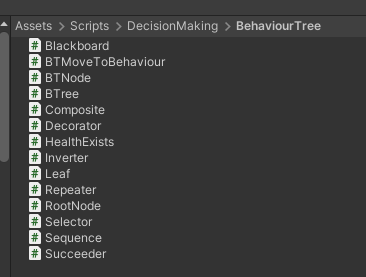First, I wanted to make my agent have a base state of wander make it look like they are exploring the map while not in danger. By utilising my previous wander implementation, and Jump Point Search (JPS) pathfinding the agent was able to wander without getting caught on walls.
After getting pathfinding working for my agent to wander around the map it made sense to create a new leaf node that would change the target position of the pathfinding to the pickup location, this was done using the actions inside of unity to listen for when a pickup is spawned and set the target locations in the dictionary and conversely if the pick up is collected then the locations are reset in the dictionary and the wandering begins again. Deciding on which pickup to go for comes down to the players health, while using different guns can be useful once bellow a certain health the agent is in danger of getting swamped by enemies before having time to react.
Shooting and evading were created with the other in mind while shooting at an enemy it is likely we want to be backing away from them to limit the danger from them. However, I wanted to keep each node as decoupled from the others as possible, this led to ordering them in the tree appropriately. As the agent won’t be firing at an enemy unless there is one close then it is safe to assume there is no enemy to flee from, so using a sequence for these two nodes specifically means that if the agent doesn’t find anyone to shoot, we don’t bother trying to find an enemy to flee from. After implementing both of these nodes I ran into an issue where the agent would try to flee from or shoot at an enemy behind a wall, this was a quick fix by firing a raycast at the enemy the agent is trying to shoot and if that ray had hit a wall before the enemy ignore it as it is not in line of sight, this can be seen in the video, especially towards the end, with the red lines locking onto the enemies and if they are behind a wall they break.
Finally, I wanted to switch weapons based on certain conditions, for this I wanted to try and recreate what weapon I would likely select, this meant that if the rifle has ammo, I want to be using it unless there are main enemies, or I am low on health. Putting this node into the tree took some consideration as the agent should select the gun before shooting the enemy but not get locked into choosing a weapon and not shoot, after some testing I put the node before the shooting node as it I felt it gave the more believable behaviour.
